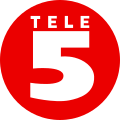Sky Sci-Fi is a British pay television channel owned and operated by Sky, a division of Comcast. It was launched in 1995 as a localised variant of the US network Sci Fi Channel, with a similar programming line-up. It was on air each day from 8;00 am until 2:00 am, but only on cable as a lack of transponder space on satellite meant that it was only able to broadcast for few hours each day on that platform. It wasn't until the launch of Sky Digital in 1998 that the channel's full broadcast hours were available on satellite.
Television in the Netherlands was officially introduced in 1951. In the Netherlands, the television market is divided between a number of commercial networks, such as RTL Nederland, and a system of public broadcasters sharing three channels, NPO 1, NPO 2, and NPO 3. Imported programmes, as well as news interviews with responses in a foreign language, are almost always shown in their original language, with subtitles.

ProSieben is a German free-to-air television network owned by ProSiebenSat.1 Media.

Italia 1 is an Italian free-to-air television channel on the Mediaset network, owned by MFE - MediaForEurope. It is oriented at both young and adult people.
Arte is a European public service channel dedicated to culture. It is made up of three separate companies: the Strasbourg-based European Economic Interest Grouping (EEIG) ARTE, plus two member companies acting as editorial and programme production centres, ARTE France in Paris and ARTE Deutschland in Baden-Baden.

CTV Sci-Fi Channel is a Canadian English language discretionary specialty channel owned by Bell Media. The channel primarily broadcasts speculative fiction and related programming.
RTL, formerly RTL plus and RTL Television, is a German-language free-to-air television channel owned by RTL Deutschland, headquartered in Cologne. Founded as an offshoot of the German-language radio programme Radio Luxemburg, RTL is considered a full-service broadcaster under the Medienstaatsvertrag and is the largest private television network in Germany. As of August 2010, RTL employs some 500 permanent staff, having outsourced its news and technical departments.

RTL Zwei, formerly spelled RTL 2 and RTL II, is a German-language television channel that is operated by RTL2 Television GmbH & Co. KG. RTL2 is a private television broadcaster with a full program (Vollprogramm) according to the Interstate Broadcasting Agreement (Rundfunkstaatsvertrag). For Austria and Switzerland, variants of the main programme are produced with nationally inserted advertising islands; these variants can be received via the cable networks in these two countries as well as via digital satellite. RTL Zwei is the second subsidiary of RTL Group in Germany.

Canale 5 is an Italian free-to-air television channel of Mediaset, owned by MFE - MediaForEurope. It was the first private television network to have national coverage in Italy in 1980. On 4 December 2012, Mediaset launched Canale 5 HD, a simulcast of Canale 5 in high-definition. The channel is aimed at a primarily adult audience, offering, mainly, entertainment, movies and TV series. Since January 2013, Canale 5 has been directed by Giancarlo Scheri.
Television in Germany began in Berlin on 22 March 1935, broadcasting for 90 minutes three times a week. It was home to the first regular television service in the world, named Fernsehsender Paul Nipkow.
Ruck Zuck is the German version of the short-lived U.S. game show Bruce Forsyth's Hot Streak. It premiered on January 11, 1988, and ended on October 20, 2000 and four years later it came back to Tele 5 on October 25, 2004 and ended on June 3, 2005. Like its American counterpart, the series was packaged by Reg Grundy's Worldwide television empire. During its 1988–2000 and 2004–2005 run, Tele 5, RTL II and tm3 in its original incarnation, ran the show. The show was revived on RTLplus from October 17, 2016 to December 8, 2017.
La Cinq was a French free-to-air television channel. Created by politician Jérôme Seydoux and Italian media mogul Silvio Berlusconi, it existed from 1986 to 1992.

RTL9 is a French-language Luxembourgish television channel shown in Luxembourg, France, Monaco, Africa and the French-speaking regions of Switzerland.
tm3 was a German free-to-air television network. On 1 September 2001, it was rebranded as 9Live, which eventually closed down on 9 August 2011. TM3 was revived on 13 January 2019 replacing Family TV. On 31 March, Genius Family replaced Tm3.
ProSieben Maxx is a German free-to-air channel owned by ProSiebenSat.1. The channel started broadcasting on 3 September 2013 with the movie Captain America: The First Avenger at 8:15 p.m. On 30 July 2013 ProSieben Maxx received a DVB-T broadcasting licence for the region of Munich. On 13 August 2013 the channel started a test program on these frequencies and broadcast some program trailers. It is ProSiebenSat.1's sixth channel.
Leonine Holding GmbH, LLC, formerly Tele München Group, LLC, is a media company based in Munich.
RTL Crime is a German pay television channel owned by the RTL Group. The channel was launched on 27 November 2006. Its programming is centred towards action and crime series.

musicbox was the first German music channel on television. It was launched in 1984, first via the cable pilot project and then as a nationwide television channel. In 1988 the station was converted into Tele 5.
Carsten Schaefer is a German TV and radio host, professional wrestling commentator and ring announcer best known for his time in WWE. He has hosted WWF/E shows for over 30 years. Nobody worldwide commented WWF/E shows that long in a row.















